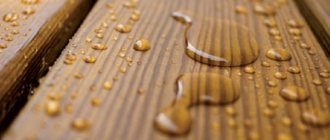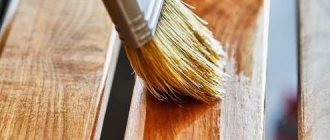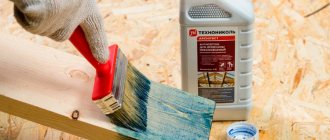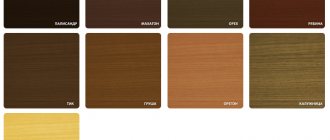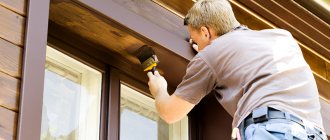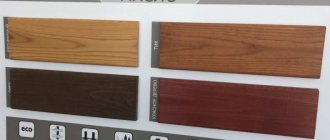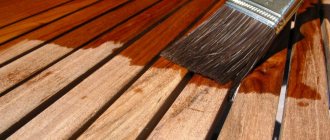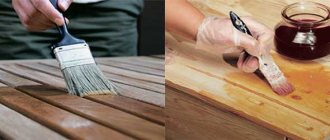It’s not a problem to buy store-bought wood wax, but the price is steep, and most importantly, you’re not 100% sure that you’re getting a natural product. People are now drawn to everything natural, so I have collected 5 proven compositions that you can prepare with your own hands. Here you will find wax and oil for wood, both for exterior and interior use, plus compounds for wooden utensils.
It’s quite possible to make oil wax for wood with your own hands.
Why is waxing necessary?
In order to use wood in construction, a protection procedure is required. Mainly, this is protection from moisture, which can penetrate into the structure and destroy it, because of this the material swells and deforms.
Even fungus or mold may develop. To prevent this, wood has long been treated with wax.
- Wax and oil allow you to create a protective film on the material without changing its appearance or giving the material excessive thickness.
- Oil is usually used for those structures that have been exposed to sunlight for a long time, that is, this treatment is more suitable for outdoor work.
- Waxing is used for interior work, where the material will not be exposed to the sun and precipitation.
Wax is able not only to create a protective film, but also to penetrate inside the wood, thereby protecting its structure from the inside. At the same time, the coating does not close the pores, the material still breathes and remains natural.
The coating is universal, suitable for any species, even such a noble and expensive one as ash. Its appearance is preserved, the natural pattern is emphasized and the structure is protected from influences.
Various chips and cracks, which could be either natural or physical, obtained when working with the array, are also well masked.
Technology of use
The substance must be used in accordance with the instructions, which are often supplied by the manufacturer. If this is not included in the package, you should use the tips below. Depending on the type of substance, the method of application will vary:
- Technology of working with soft wax. For the procedure you will need the product itself, a small spatula, felt material, and a construction knife with a sharp blade. Products are restored by filling voids with furniture wax. To do this, you need to scoop up the substance with a spatula and apply it to the scratch or hole. Excess wax is removed with a knife: this must be done carefully so as not to provoke the appearance of new scratches. Smoothing of the material occurs thanks to the plastic corner. At the final stage, the furniture is polished with felt cloth to ensure a uniform structure;
- How to apply hard furniture wax. To work, it must be melted using a lighter, soldering iron or gas torch. Once the material has heated up, it is necessary to reach room temperature for better adhesion to the furniture. The material is applied to the chip and leveled. If necessary, the surface of the furniture is sanded.
It happens that during the repair process all the wax was not removed from the surface. To remove the wax from the product, you need to use ice cubes. To do this, take several pieces of ice, put them in a bag and remove the wax from the furniture by applying cold ice to the stains. The wax will harden and cool, after which it can be carefully removed using improvised means.
If the product is not wiped off, you can use solvents that are suitable for wooden surfaces. First you need to check the composition on an inconspicuous place of the furniture, and then start cleaning. Furniture wax is a universal product for the restoration and repair of furniture, floor coverings, doors, windows and other wooden surfaces: it will help restore the former beauty of all of these items.
Cleaning the surface
Melt wax if required Apply to scratches
Advantages and disadvantages of the waxing procedure
Such a coating has a number of undeniable advantages:
- Protection against water ingress;
- The tree does not stop breathing;
- Protects against fungi, mold, dust and dirt;
- The surface becomes less susceptible to scratches;
- Universal, suitable for different types of arrays;
- It is possible to choose a different color palette;
- Wax does not produce toxins and is safe to use and continue to use the wax-coated product;
- Allows you to protect the surface for a long time, while the appearance of the product does not lose its beauty;
- The tree retains a pleasant smell.
Very often barrels are treated with the composition. This allows you to preserve both containers and drinks without losing their quantity and quality.
There is only one drawback worth noting. This is because wax makes wood melt more easily. Also, if alcohol gets in contact with the treated material, stains may remain.
As a rule, this treatment is not suitable for kitchen work surfaces, as well as for those places with frequent contact, for example, armrests of furniture. The effect will be too short-lived, you will have to carry out the procedure often.
Features of the use of waxed products
With all the advantages of the method of treating wood with liquid wax, it should be remembered that wax is a material sensitive to high temperatures. Under their influence he “floats”. Therefore, you need to take into account the features of the room in which future furniture or wood products will be used. Although the heat resistance of some modern industrial samples of liquid wax reaches 100 0C. However, you should not wax your kitchen work surfaces. If you accidentally spill hot food or place heated dishes, traces will remain. Which can only be removed by repeated waxing.
Wax is not compatible with products containing alcohol. When choosing a care product for waxed furniture, you should carefully read the composition and instructions. In general, it is enough to simply wipe it with a dry soft cloth, and to remove dirt or remove fingerprints from time to time use special cleaners with the obligatory mark “for waxed surfaces.”
Subject to application technology and proper care, coating wood products with liquid wax will ensure a long service life and a noble appearance.
Types of compositions
Most often, the treatment is carried out not only with one wax, but usually with several formulations, which contain this ingredient.
There are three types of compositions:
- In its soft form, wax can be used to treat the surface frequently and regularly. The coating is obtained with a thin layer, masks scratches and stains, protects against water and insect damage;
- If you need to treat a large surface area, it is better to use liquid wax for this purpose. Can be used simultaneously with dyes of organic and synthetic origin to change the shade of wood;
- If you have a material that needs to be restored from damage and severe breaks, use wax in solid form. It fills all unevenness well and becomes smooth with careful polishing.
The composition of such coating materials contains wax and oil. Usually they take processed products from orange or flax. Wax facilitates the penetration of the composition into the rocks, and oils create protection.
They also take wax of plant origin - carnauba. It is suitable for all surfaces that are subject to constant exposure and wear out quickly. For example, handles or steps of stairs. The composition is prepared only before application, hardens quickly and provides reliable coverage.
Selection of oil-wax
The key criterion is the composition of the product, what components are included in it. The final result and tone of the wood directly depend on this.
The product consists of:
- oil (linseed, olive or jojoba);
- beeswax;
- colors for color saturation;
- a solvent that makes the product not so thick (the lower its mass fraction, the faster the hardening occurs).
If you buy a ready-made product, make sure that the composition does not contain aggressive solvents or benzene. It is also necessary to take into account the type of wood, since both the absorption rate and the consumption of the product directly depend on this. Compositions for hardwood, softwood and exotic woods are available.
Oil-wax often contains additives that make the surface glossy and shiny. It looks impressive, and this product is suitable for interior work. But be careful, as the coating becomes slippery when treated with the composition.
What you need for waxing
In order to apply wax correctly, you will need a number of tools. You need to prepare them before work:
- Directly wax;
- Sandpaper for polishing the surface;
- Solvent or cleaner;
- Sharp knife;
- Brushes for applying the composition;
- Brush;
- Cloth.
After everything is ready, you can proceed directly to the work itself.
Using mixtures of different consistencies
The choice of wax mixture based on consistency depends on the texture of the wood, the depth of cracks on the surface and their number. Minor damage is taken into account.
- A liquid composition or oil wax is used for application to surfaces with a large number of microdamages, with a small penetration depth. Oil wax contains a lot of natural solvent, which makes it look like regular varnish.
- A solid wax mass is applied to the surface with deep cracks if chips have appeared.
- Due to its variety of colors, soft wax (reminiscent of mastic) is matched to the interior so that the wooden item looks in tandem with textile elements.
Manufacturers offer the wax composition in jars of different capacities. Knowing its consumption, the material is purchased once for the entire wooden structure. A small area of wood is treated with a wax pencil.
Step-by-step instructions for waxing wood
The procedure is carried out in several stages:
- Before application, the surface must be thoroughly cleaned. If there is old coating, it must be cleaned down to the wood itself. Then you need to polish the material using sandpaper. If necessary, it is also impregnated with stain;
- Then the wax itself is applied in 2 or 3 layers. Initially, the composition is applied along the fibers, then the first layer, and after everything has dried, as a final stage, it is applied again, as the first time, in the direction. Apply the composition using a brush or cotton swab, rub it in with a piece of lint-free cloth;
- Once the composition has dried, it can be polished. It takes 7 hours for final drying; you can check whether the wood is ready for polishing or not with your hands. If nothing sticks, proceed to the beginning of the stage. A large area is polished with special devices; for a small area, you can use small pieces of lint-free fabric;
To make the coating last longer, you can coat the top with a special varnish. it must have a water base.
Varieties
Today, you can find two types of furniture chalk on sale in hardware stores: solid and liquid. Each of them has a number of advantages and disadvantages, as well as different methods of use. To figure out which option to choose for your home, we suggest studying the summary table for the two types of crayons.
| Wax type | Purpose | Nuances of use | pros | Minuses |
| Soft | Repairing chips, cracks, scratches and other defects on horizontal wooden surfaces. Suitable for sealing marks from self-tapping screws and broken corners of the table top. | Apply with a spatula, after which the excess is removed with a felt disc. Ideal for filling large and deep surface voids. | Easy to use, available and sold in any store. | Not suitable for processing furniture that will subsequently be exposed to chemicals and ultraviolet radiation. |
| Solid | Repairing scratches and chips on doors, windows, and wooden interior items. | It is necessary to use solid furniture wax only in molten form. | High degree of protection against mechanical damage and temperature. | Difficult to find on sale, high cost, poor color palette. |
It is worth highlighting liquid wax separately, which is applied to the surface of the products using a small spatula. Its disadvantage is that it cannot be used on vertical planes. In consistency, it resembles drying oil - this mixture is achieved by the presence of synthetic substances and solvents. Its advantage is that the material penetrates holes of any diameter and depth, filling the gaps.
To use the solid type, a wax melter is used, which allows you to soften the structure of the substance, preparing it for work. This can also be achieved without special devices, for example, using a household hair dryer.
Today you can find the product on sale in several forms: wax crayons, as well as jars with a liquid composition. If wax will be used at home occasionally, it is better to take a wax pencil.
DIY coating
You don’t have to buy a ready-made mixture, but prepare it yourself. Moreover, there is nothing complicated in the recipe.
- The wax needs to be melted in a water bath, then pour in turpentine.
- These ingredients are taken in a ratio of 1 to 2.
- But rosin is added in a ratio of 1 to 4.
All this is thoroughly mixed so that there are no large particles and all the crystals are dissolved.
How much does 1 kg of paraffin cost?
Price list
| № | Name | Price |
| 3. | Refined solid petroleum paraffin (STO 00148636-004-2007) | negotiable |
| 4. | Solid petroleum paraffin, grade T-2 (GOST 23683-89 with amendment 1), original packaging | 72.5 rub/kg |
| 5. | Solid petroleum paraffin, grade T-2 (GOST 23683-89 with amendment 1) | 72.0 rub/kg |
| 6. | Petroleum match paraffin Ns (TU 38.1011322-90) | 57 rub/kg |
